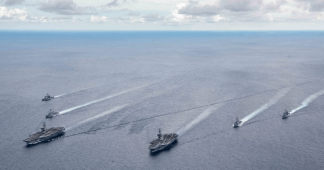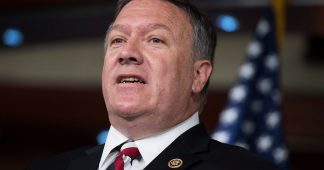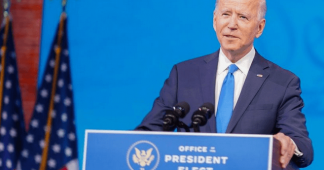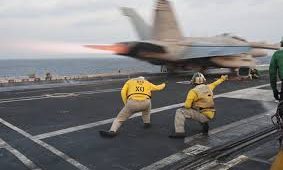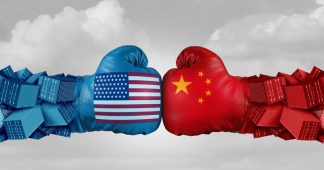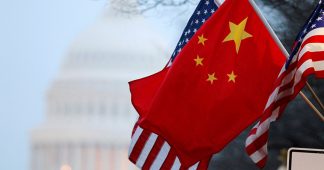By Peter Symonds
As the Biden administration has deliberately intensified the US confrontation with China, Taiwan has rapidly come into focus as the spark that could trigger a war between the two nuclear-armed powers. Biden, following on from Trump, is questioning and undermining the diplomatic framework that has maintained an uneasy and precarious peace across the Taiwan Strait for decades.
By strengthening ties with Taiwan, the US is calling into question the One China policy that was the basis for establishing diplomatic relations between Beijing and Washington in 1979. It is also encouraging Taipei to take a far more aggressive stance towards China adding to the danger of conflict, and fueling fears in Beijing that Taiwan’s ruling Democratic Progressive Party, which advocates greater autonomy from China, could declare full independence—a red line for Beijing.
Speaking to reporters on Monday, Taiwan’s foreign minister, Joseph Wu, took note that “American decision makers” were warning of the danger of China launching an attack on Taiwan. He bluntly declared that Taiwan would throw everything into a conflict with China “We will fight the war if we need to fight the war. And if we need to defend ourselves to the very last day we will defend ourselves to the very last day,” he declared.
Wu’s comments were followed on Wednesday by threats from Lee Chung-wei, who heads Taiwan’s Ocean Affairs Council, that Taiwan would shoot down Chinese drones that came too close to the Pratas Islands controlled by Taipei in the South China Sea. Lee claimed that Chinese drones had been spotted but acknowledged that none entered the restricted waters and airspace extending 6 km from the islets. But if they had entered, he said, “it will be handled under the rules. If we need to open fire, we open fire.”
These statements are testimony to the extraordinary tensions that the US is stoking in the Indo-Pacific. Denunciations of “Chinese aggression” and “Chinese expansionism” from Washington, parroted by US allies and partners around the globe, stand reality on its head. US imperialism has over the past decade carried out a huge military build-up throughout the region and deliberately inflamed potential flashpoints, including the South China Sea and the Korean Peninsula.
On Wednesday, the US Navy sent another warship through the sensitive Taiwan Strait between Taiwan and the Chinese mainland which is just 130 km wide at its narrowest point. The guided missile destroyer USS John S. McCain became the fourth naval vessel to make the “transit” since Biden took office. If the tempo is maintained, the Biden administration will eclipse the record of 13 transits set by the Trump administration last year.
On the same day, the aircraft carrier USS Theodore Roosevelt, and its associated strike group, carried out military exercises in the South China Sea, including fixed- and rotary-wing flight operations, maritime strike exercises and anti-submarine operations. It is the second time this year that the huge nuclear-powered carrier and its armada have carried out war games close to the Chinese mainland and key naval bases in southern China. “[Our] war-fighting prowess is unmatched,” the commanding officer Captain Eric Anduze boasted.
The US Navy has also carried out at least two so-called Freedom of Navigation Operations (FONOP) in the South China Sea since Biden came to office. US warships directly challenge Chinese maritime claims by sailing close to Chinese-controlled islets—provocative manoeuvres that have the potential to trigger a military clash either by accident or design.
On the pretext of “freedom of navigation,” Washington declares that these military exercises close to the Chinese coast line are legitimate. But when it comes to the operations of Chinese military aircraft and naval vessels, these are always portrayed in the most sinister light. Yesterday, Taiwan scrambled fighter jets in response to an “incursion” by 15 Chinese aircraft into Taiwan’s self-declared air defence identification zone—broad airspace restrictions that have no standing in international law.
At the same time, the US and international media played up the exercises in the Pacific involving China’s aircraft carrier, the Liaoning, and five escort ships which passed through the Miyako Strait in the Japanese Ryukyu Islands on Sunday. The strait is wide enough that the waters are international and no Chinese violation of Japanese sovereignty was involved.
Two top US military figures—the former head of the Indo Pacific Command Admiral Philip Davidson and the incoming head Admiral John Aquilino—both warned of the heightened danger of US war with China over Taiwan in the near future. Davidson declared that “the threat is manifest during this decade—in fact, in the next six years,” while Aquilino, when asked at his congressional confirmation hearing, said “this problem is much closer to us than most think.”
Since 1979, the US has adhered to the One China policy, in effect recognising Beijing as the legitimate ruler of all China, including Taiwan. As a result, the US has no formal diplomatic relations with Taiwan and any contact has been low key. At the same time, under the Taiwan Relation Act, the US has continued to supply defensive arms to Taiwan and offer an assurance that it would come to Taiwan’s defence in the event of a Chinese attack.
By elevating the levels of contact with Taiwan, including a visit last year by a US cabinet lofficial, Health and Human Services Secretary Alex Azar, the Trump administration effectively undermined the previous diplomatic protocols associated with the One China policy. Trump’s Secretary of State Mike Pompeo early this year went a step further ending all restrictions on contact between US and Taiwanese civilian and military officials—a policy that Biden, who declared his commitment to Taiwan as “rock solid,” is continuing.
Under the Biden administration, the Pentagon is considering stationing offensive intermediate range missiles on what is known as the first island chain ringing the Chinese mainland—including on Taiwan. The US is also assisting in the expansion of Taiwan’s submarine fleet. Taiwan is also developing its own indigenous offensive missiles to strike deep within China.
The US is recklessly playing with fire. As part of establishing diplomatic relations with Beijing in 1979, the US broke relations with Taiwan and withdrew its military forces. Any attempt by the US to station its troops or military hardware on Taiwan would draw a hostile response from China and threaten to precipitate military conflict.
A great deal is at stake. Taiwan is both strategically and economically significant. As part of the first island chain, it would be a key element in an attempt by the US either to impose an economic blockade on China or to launch a full-scale war. At the same time, it is home to the Taiwan Semiconductor Manufacturing Company, which accounts for some 90 percent of the production of the most advanced computer chips that are required for a wide range of both commercial and military applications.
The warnings by US admirals of war with China in the near term have far more to do with fears in Washington that China is overtaking the US economically and strategically, than with “Chinese aggression.” The heightened discussion in Washington over the need for strong ties with Taiwan makes clear that this strategic island is a major component of the Pentagon’s planning for war with China. US imperialism is prepared to use military means to shore up its global dominance—even if it leads to a calamitous nuclear conflagration.
Facing a rapidly emerging class struggle at home, the US ruling class is also seeking to turn these immense social tensions outward against an external enemy. Workers and youth should reject the rising tide of propaganda demonising China in increasingly racist terms and turn to the Chinese working class which faces the same forms of capitalist exploitation. The only means for ending the danger of war is to build an international antiwar movement of the working class on a socialist basis to put an end to capitalism—the root cause of war.
Published at www.wsws.org
